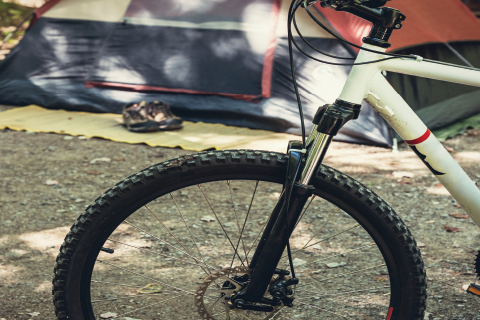Sprints to Failure

Flying along the “Sweet 16” trail of the Barton Creek greenbelt, mountain bike riders encounter a series of short, technical climbs. Each one requires power, focus, and—as the climbs come consecutively—endurance. The effort required during most mountain bike races goes like this: an hour-plus of slow burn, punctuated nearly every minute by very intense, shorter efforts. This presents unique training challenges. To be successful, mountain bikers must have a big engine as well as the ability to produce short, high-powered efforts, all while maintaining the focus to navigate technical difficulties.
As a professional mountain biker, I am often asked what my hardest, most effective workout is.
Without giving away too many training secrets, I usually answer that the workout varies. Some days, it’s suffering—being out of hydration and out of food—through the last hour of a five-hour “base ride.” Other times, it’s staring at the wattage numbers of my power meter as I turn myself inside out in an attempt to set a new 20-minute power test PR.
With today’s multitude of technologically advanced training tools such as heart rate monitors and power meters, sophisticated training is more accessible. Everyone from the local weekend warrior to the Tour de France contender can enjoy the motivating effects that come with real-time performance feedback. I find my power meter often acts as a sort of cheerleader: “360 watts? How about shifting one more gear… 365… 370. Hold it there! Hold it there!”
Chasing numbers can be a double-edged sword though. Some days when I’m not feeling as good, it’s tempting to use it as crutch—riding at the bottom of a prescribed training zone and calling it “good enough.” One of the hardest, most effective workouts my coach Christian Williams with Williams Racing Academy has me do doesn’t require any gadgetry. There’s only one number that matters: 100. As in, 100 percent.
Below that workout description on my training plan, Williams has written: “We’re not measuring heart rate or power today. We’re measuring guts, fortitude, discipline, and fight.”
Yikes! Although the workout I’ve given here will do wonders for physical fitness, it is equally about practicing the mental side—allowing the mind to focus under stress and unlock levels of physical effort that it previously protected.
Because the session is so intense, it is especially important to get a good warm-up. What constitutes a thorough warm-up varies with the experience of the cyclist. For some, 20 minutes of easy spinning with a few short “jumps” is enough, while others need more. I generally do the same warm-up for this workout as I do for a race: 40 to 50 minutes, with three to five efforts varying from 5 minutes to 20 seconds.
Although perfect for off-road racing, this workout is best done on a smooth surface where the sprint efforts won’t be interrupted, such as on pavement or a dirt road.
Find an open section that takes 10 to 15 seconds to cover while at full sprint. Since you’ll be going all out, watching the timer on your handlebars is next to impossible, and again, specific numbers aren’t as important for this workout. I like to pick two landmarks that are about the right distance apart (say, a mailbox and a telephone pole). One is my starting line, the other my finish.
The goal of this workout is to sprint to failure. Give every ounce of effort you have for 10 to 15 seconds, then spin easy for 30 to 60 seconds. And do it again. And again. Eventually, you will totally fall apart and likely not be able to get out of the saddle anymore to sprint. The beauty of this workout is that it’s up to you. There’s no chasing of power numbers or heart-rate zones. It’s all about the athlete being true to his or her effort.
Because the “on” period is so short, it will take at least a handful of sprints for fatigue to build. This will help build that repeatable max power so important to mountain biking. At the same time, the athlete doesn’t get complete recovery between the efforts, so there is that “constant burn” aspect also critical in a mountain bike race. Although this is a great high-end workout for the month or two before a big event, I like to utilize it nearly year-round. It’s an efficient use of time and when finished, I know I got better.
Workout
Warm-up
20–50 minutes—depending on athlete, but be thorough
Workout
10–15 second sprints, with 30–60 seconds recovery between, until failure
Cool-down
10+ minutes of easy spinning
Tips
If training for mountain bike racing, do these on your mountain bike. The sprint position is different than on a road bike.
I often do these on a dirt road or path instead of pavement. It gets me that little bit more in touch with the stabilizing muscles required to control a mountain bike. However, avoid bumpy terrain that will interrupt your pedal stroke.
More advanced riders can incorporate multiple sets and couple these sprints with a larger workout.






